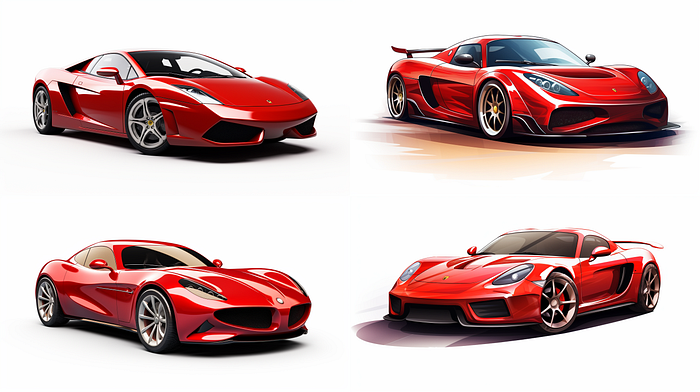Diving into the world of AI-generated images, one soon realizes the power of background settings. With Midjourney, a leading AI platform for creating visuals, the potential to craft stunning backdrops is immense. Yet, as I’ve discovered, there are nuances to consider.

Through my exploration and experiments, I’ve found that backgrounds in Midjourney can be broadly categorized into four distinct types. Each type offers its own set of possibilities and challenges. Let’s delve deeper and discover the art of defining backgrounds in Midjourney.
This tutorial is explained in detail in a YouTube video in Arabic with English subtitles.
1. Simple Backgrounds
In the realm of Midjourney, the simplest way to depict a background is by opting for a solid color. This straightforward approach ensures that the main subject of your image stands out, free from the potential distractions of a more intricate setting.
Prompt Examples:
Red sports car, white background --ar 16:9

Red sports car, black background --ar 16:9

Interestingly, when I experimented with two distinct colors for the background, the results were less predictable.
Cautionary Example:
Yellow car, red and green background --ar 16:9
In situations like these, Midjourney might get a little baffled. The software occasionally blends the colors or even modifies the primary subject’s hue.

2. Gradient Backgrounds
Gradient backgrounds involve a smooth transition between two or more colors. It’s a subtle progression from one hue to another, often providing a sense of depth and dimension.
When working with a single color gradient, such as “blue gradient”, Midjourney effectively captures the essence of the gradient.
Prompt Example:
Yellow sports car, blue gradient background --ar 16:9
gives the car an aura by enveloping it in a gradient of blue shades.

However, challenges arise when we add more specific details into the mix. An attempt to set both a floor color and a wall with a gradient, such as:
- “yellow sports car on a green floor, blue gradient wall” often confuses the AI. Instead of a clear distinction between the green floor and the blue gradient wall, Midjourney might blend the colors, or in some cases, apply the background colors to the subject (the car in this instance).
Prompt Example:
Yellow sports car on a green floor, blue gradient wall --ar 16:9

3. Descriptive Backgrounds
Venturing beyond solid colors and gradients, descriptive backgrounds are where you can let your imagination roam free.
Prompt Example:
Eagle soaring with a background of a majestic mountain range covered in mist --ar 16:9

4. Complex Backgrounds (Layers)
For those seeking a more intricate visual narrative, layered backgrounds encompass various elements contributing to the image’s setting. This includes the foreground, middle ground, and the far-off background.
- Foreground: The part closest to the viewer, usually detailed and prominent.
- Middle ground: The intermediate part, offering depth and space.
- Background: The furthest part, providing context behind the main subject.
Prompt Example:
A young girl in a red dress sitting on a rock in the foreground, a sparkling blue river winding through the middle ground, and a towering snow-capped mountain range in the background --ar 16:9

Conclusion
Exploring Midjourney’s capabilities has been a revelatory journey for me. The platform’s versatility in crafting backgrounds, from the simplest to the most intricate, is genuinely impressive. However, it’s essential to approach each prompt with clarity and specificity to achieve the desired outcome.
The world of AI-driven design is vast, and there’s always something new to learn. Let’s navigate it together!


